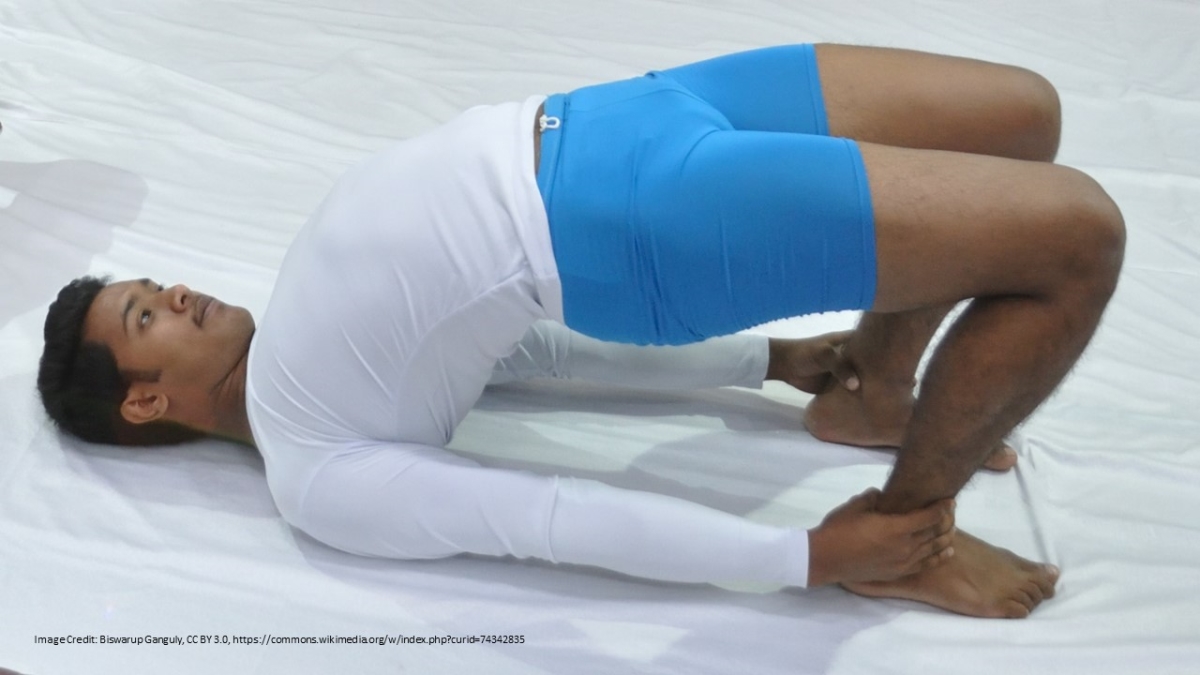Introduction
Setu Bandhasana is also known as Setu Bandha Sarvangasana or simply Setu Asana. Classic Yoga texts did not mention this pose. However, we could find evidences that this yoga pose has been in traditional yoga practice, if not with the same name. Sritattvanidhi, the nineteenth century (1868 BC) treatise on Iconography of South India mentions this posture as Kamapidasana (Kāmapīṭhāsana).
Moreover, Sri Krishnamacharya in his book Yoga Makaranta states that this yoga pose was called Uttana Mayurasana in Yoga Kurantam, a classical yoga text that is not extant today.
Hence, it is a myth that it is a modern yoga pose.
While Sri Krishnamacharya calls it Setubandhasana, B.K.S. Iyengar calls Setubandha Sarvangasana. Bihar school of Yoga calls this pose Setu Asana. However, the latter one is
Setu Bandhsana Information
| Pose Name | Setu Asana Setu Bandhasana Setubandha Sarvangasana |
| Sanskrit Name | सेतु आसन सेतु बन्धासन सेतुबन्ध सर्वाङ्गासन |
| IAST Name | setu āsana setu bandhāsana setubandha sarvāṅgāsana |
| English Name | Bridge Pose Bridge Lock Pose Shoulder Supported Bridge |
| Origin | Traditional Yoga Practice |
| Difficulty Level | Intermediate |
| Other Names | Uttana Mayurasana Kāmapīṭhāsana |
| Type | Inverted Pose |
Setu Bandhasana Meaning
Setubandhasana is the combination of three Sanskrit Words: सेतु (Setu), बन्ध (Bandha), and आसन (Asana). Setu means Bridge. Bandha is a lock. As we already know, Asana means a yoga pose.
In English, it gets the name Bridge Pose or Shoulder Supported Bridge. However, Bridge Pose is more familiar one.
Setu Bandhasana Procedure
Bridge Pose Precautions and Contraindications
Pregnant ladies should avoid this pose. Similarly who are undergoing monthly period should avoid this practice.
This pose is contraindicated in health conditions like Cervical Spondylosis, Hernia, shoulder and neck issues, and lower spine disorders.
Bridge Pose Preparatory Poses
The practice of following poses will prepare the practitioner to master Bridge Pose.
Setu Bandhasana Steps
Step 1
Perform Salamba Sarvangasana. Throw the legs back to the floor, bending the knees. While doing this, keep the spine with the support of palms.
Step 2
Keep the legs together. Release the hands off the spine and place it straight on the floor. If possible, reach out to the ankles and hold them. Now the body forms a bridge. The legs and shoulders bear the weight of the bridge.
Step 3
Breath normally and keep the position as long as it is comfortable. To release the position, take of hands from ankles, and stretch down the legs one by one to bring the body down to the floor.
Duration
A beginner may retain the final position for a duration of 30 to 60 seconds. Over time, he can extend the duration up to three minutes.
Follow Up Poses
Matsyasana is the perfect counter pose one should practice after this pose. If one could not practice Matsyasana for any reason, the following poses may be considered.
- Wheel Pose
- Bow Pose
Setu Bandhasana Benefits
The following are the benefits of Bridge Pose.
- It improves the flexibility of the spine. The health of the spine plays an important in the overall health of the body. Hence it contributes to the health of the whole body.
- It strengthens the neck and shoulder region.
- Bridge Pose is good for conditions like sciatica and Lumbago.
- Setu bandhasana stimulates Thyroid gland. As a result, it improves its functions and prevent diseases of Thyroid Gland.
- It activates Visuddhi Chakra. Thus it helps in Kundalini yoga.
